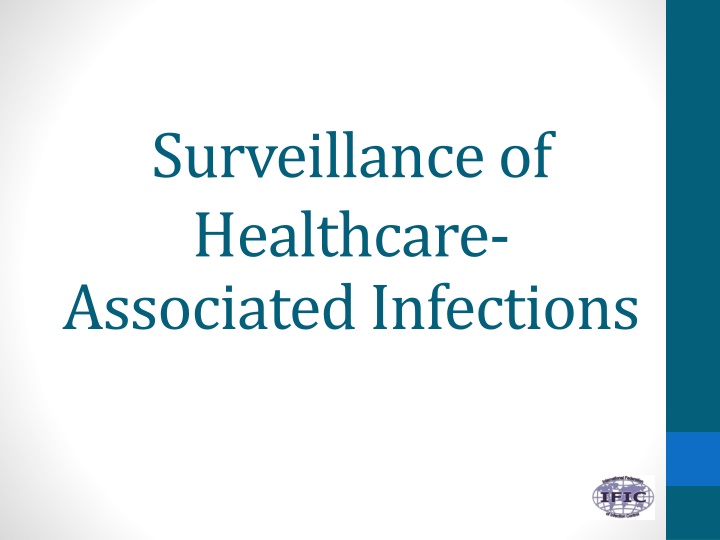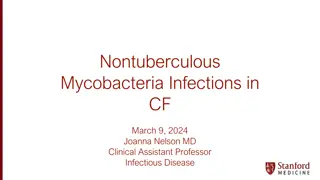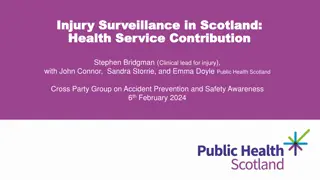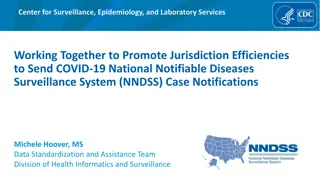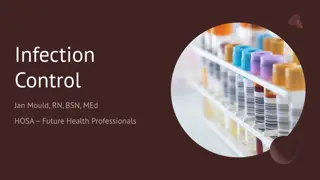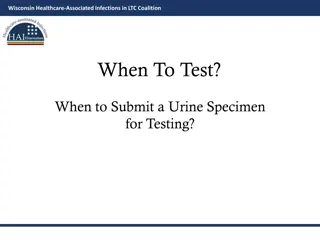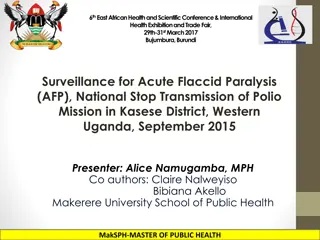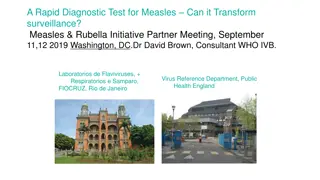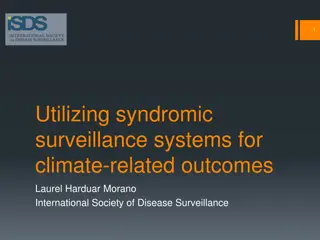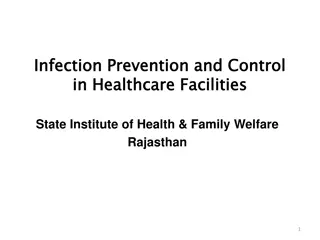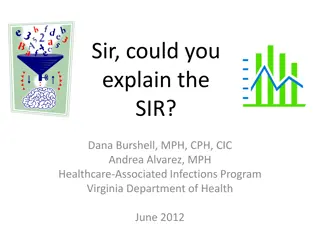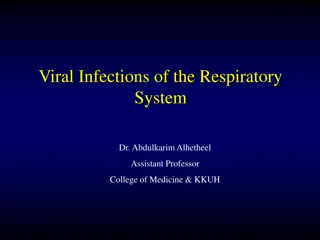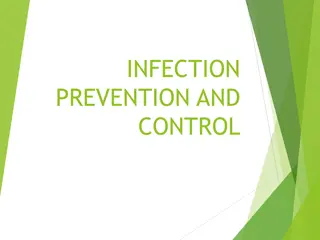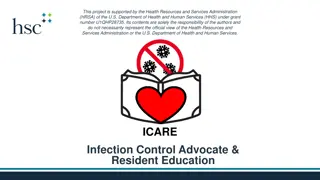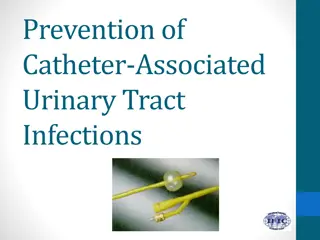Surveillance of Healthcare-Associated Infections
Infection surveillance in healthcare settings plays a crucial role in identifying problems, prioritizing prevention activities, and enhancing patient safety. This content delves into the aims, process, and benefits of surveillance, highlighting its role in improving care quality and reducing risks. With a focus on assessing the population, selecting surveillance outcomes, and analyzing data, this information provides valuable insights for healthcare professionals involved in infection control and prevention.
Download Presentation

Please find below an Image/Link to download the presentation.
The content on the website is provided AS IS for your information and personal use only. It may not be sold, licensed, or shared on other websites without obtaining consent from the author.If you encounter any issues during the download, it is possible that the publisher has removed the file from their server.
You are allowed to download the files provided on this website for personal or commercial use, subject to the condition that they are used lawfully. All files are the property of their respective owners.
The content on the website is provided AS IS for your information and personal use only. It may not be sold, licensed, or shared on other websites without obtaining consent from the author.
E N D
Presentation Transcript
Surveillance of Healthcare- Associated Infections
Learning Objectives December 1, 2013 1. Explain the purpose or aims of surveillance. 2. Discuss how to establish a system for healthcare-associated infection surveillance. 3. Differentiate between continuous surveillance and periodic prevalence surveys. 2
Time involved December 1, 2013 45 minutes 3
What is Surveillance? December 1, 2013 The systematic observation of the occurrence and distribution of disease within a population and of the events that increase or decrease the risk of the disease occurrence 4
Aims of HAI Surveillance -1 December 1, 2013 Identification of problems and prioritising infection prevention and control (IP&C) activities Assisting the development of IP&C policies and associated clinical practices Detecting changes in the endemicity of an HAI or an adverse event Detecting changes in compliance with IP&C policies Detecting outbreaks of adverse events 5
Aims of HAI Surveillance -2 December 1, 2013 Establishing the effectiveness of an intervention Identifying whether the current program meets benchmarks Establishing data for an evidence-based plan to improve care and to meet accreditation or regulatory requirements 6
Establishing a Framework for Surveillance December 1, 2013 Infection surveillance framework includes: Assessing the population Selecting the outcome or process for surveillance Using surveillance definitions Collecting surveillance data Calculating and analyzing surveillance rates Applying risk stratification Reporting and using surveillance information 7
Assessment of the Population December 1, 2013 Assessment should evaluate: 1. High risk populations 2. High volume procedures, interventions 3. High impact infections 4. High cost infections 8
Outcome vs. Process December 1, 2013 Outcome Surveillance Decreasing risk and costs Identify gaps Process Surveillance Identify care delivery issues 9
What to consider in establishing a surveillance framework -1 Is it necessary to survey the entire health care facility or only focus on high-risk patient groups or procedures or commonly performed procedures? Have rates increased in certain groups/procedures /interventions? What is the most important IP&C-related process that is likely to be associated with this rate? How will a standard, validated, and reproducible definition of infection be applied? December 1, 2013 10
What to consider in establishing a surveillance framework -2 December 1, 2013 Should continuous surveillance or point prevalence surveys be used? How will the data be collected, stored, retrieved, summarized, and interpreted? How will results to clinicians be provided in a timely manner? How will the information be used to continue to lower infection rates? 11
Types of Surveillance December 1, 2013 Continuous surveillance or periodic prevalence surveys Alert-based surveillance Post-discharge surveillance 12
Continuous Surveillance -1 December 1, 2013 Undertaken prospectively Best way to establish trends and distribution of HAI incidence Can be active, passive, or a combination of both Active surveillance involves daily visits to patient wards/care units to assess patients at- risk of HAI 13
Continuous Surveillance -2 December 1, 2013 Case finding using active and passive surveillance by an IP&C practitioner increases correct detection of HAIs Only incidence cases of HAI should be reported 14
Prevalence Surveys December 1, 2013 A good substitute for continuous surveillance Performed on a single day or week Can show the magnitude of HAI, highlight problems requiring more investigation, and identify changing patterns of HAIs Can be used to target areas or services where infection rates are suspected to be high 15
Prevalence Survey: Line listing Area: _______________________________________ December 1, 2013 Month/quarter Year Resident/patient HAI HAI Identifiers (No=0/Yes=1) Antibiotic Name Bed Number Type of HAI Microorganism Treatment 16
Alert-based Surveillance -1 December 1, 2013 Monitor specific clinical conditions surgical site infections caused by Group A Streptococcus meningococcal meningitis Is a part of the ICP team daily work Aims to warn of early outbreaks and allow rapid control procedures 17
Alert-based Surveillance -2 December 1, 2013 Alert organism surveillance Continuous monitoring of specific microorganisms identified by the microbiology laboratory Simple and cheap, and can be automated in computerised laboratories Can show trends of specific microorganisms in different wards over time Allows the IP&C team to formulate preventive actions 18
Post-discharge Surveillance December 1, 2013 A method of identifying patients with a HAI after leaving the facility Often used for surgical site infection (SSI) detection Will identify more infections and therefore yield a higher SSI rate 19
How to Conduct Post- Discharge Surveillance December 1, 2013 A letter sent home with the patient to complete and return A questionnaire to the patients medical practitioner 20
Definitions for HAI December 1, 2013 An infection occurring during the process of care in a health-care facility which was not present or incubating at the time of admission Includes infections acquired in the health-care facility but appearing after discharge and also occupational infections among health-care workers A cut-off point 48 hours after admission is typically used to distinguish between HAI and community infections 21
What are standards or thresholds for HAI rates? Infection rates vary according to the definition used Comparisons should only be made if the same set of definitions is used and applied in exactly the same manner More meaningful to use surveillance data from same institution to measure trends to alert staff of increasing problems to monitor the effectiveness of interventions December 1, 2013 22
Surveillance Statistics: Rates December 1, 2013 Rates are calculated with a numerator (number of persons with the infection) divided by a denominator (number of persons at risk for the infection) 23
Incidence Rate December 1, 2013 Incidence rate (%) No. of patients diagnosed with new HAI during the surveillance period No. of patients at-risk of HAI during the same period x 100 24
Prevalence Rate -1 December 1, 2013 The number of cases of active HAI in a defined patient population May be new cases or ones that developed before the survey timeframe and are still active Prevalence rate the proportion of patients in the population who have an active infection at the time of the survey 25
Prevalence Rate -2 December 1, 2013 Number of new and existing cases of specific HAI during the specified survey period Total number of patients surveyed for HAI during the specified survey period x 100 26
Incidence Density Rates Based on an accumulation of person-time units with a statistically rare numerator (e.g., CLABSI) Convention is to multiply the proportion by 1,000 to be expressed as per 1,000 patient/bed/catheter days December 1, 2013 Calculation of Incidence density number of new specific HAI during the surveillance reporting period Person-time of susceptible patients at risk during the same surveillance period x 1000 27
Utilisation Ratio December 1, 2013 Number of devices per number of patient-days A measure of the total patient-days in which a high-risk device was used Can be used as a marker for risk of infection Calculate the utilisation ratios for each unit with a denominator that reflects only those patients at-risk 28
Calculation of Utilisation Ratio December 1, 2013 Urinary catheter utilisation ratio = Total number of urinary catheter-days Total number of patient-days Central catheter utilisation ratio = Total number of central catheter-days Total number of patient-days 29
Device-Associated Infection Rates December 1, 2013 Number device-associated infections for a site x 1,000 Number of device-days Infection rate per 1,000 device-days 30
Catheter-Associated Urinary Tract Infection Rate December 1, 2013 Number of catheter-associated UTI x 1000 Number of catheter-days Infection rate of catheter-associated UTI per 1000 catheter-days 31
Frequency of Data Analysis December 1, 2013 Incidence data usually analysed periodically to establish rates Typically calculated at the end of every month or quarter Prevalence data analysed immediately at the end of the survey to establish a rate that reflects that survey period 32
Summary -1 There should be a written surveillance plan for the health care facility including definitions used how data are collected the frequency of data collection who is responsible for surveillance activities Surveillance activities should support a system that can identify risk factors for infection and other adverse events implement risk-reduction measures monitor the effectiveness of interventions December 1, 2013 33
Summary -2 December 1, 2013 Surveillance plays a critical role in identifying outbreaks, emerging infectious diseases, antibiotic-resistance organisms, and bioterrorist events so that infection prevention and control measures can be instituted Surveillance program in healthcare organisations should be integrated to include infection prevention, performance improvement, patient safety and public health activities 34
References Lee TB, et al. Recommended practices for surveillance: Association for Professionals in Infection Control and Epidemiology (APIC), Inc. Am J Infect Control 2007; 35: 427-440. McLaws ML, Taylor P. The Hospital Infection Standardised Surveillance (HISS) programme: analysis of a two-year pilot. J Hosp Infect 2003; 53 (4): 260-268. Best Practices for Surveillance of Health Care-Associated Infections, 2008, Ontario Ministry of Health and Long-Term Care/Public Health Division/Provincial Infectious Diseases Advisory Committee, Canada. http://www.health.gov.on.ca/patient_safety/pro/cdad/toolkit_ricn/r ep_pidac_hai_best_prac.pdf European Centre for Disease Prevention and Control. Surveillance http://www.ecdc.europa.eu/en/activities/surveillance/Pages/Activiti es_Surveillance.aspx VICNISS Hospital Acquired Infection Surveillance System. State Government Victoria, Australia. http://www.vicniss.org.au/ December 1, 2013 35
EpiInfo December 1, 2013 Epi Info, a free software package can be downloaded from the Centers for Diseases Control and Prevention, http://wwwn.cdc.gov/epiinfo/html/downloads.htm, with a desktop calculator version accessed from http://wwwn.cdc.gov/epiinfo/html/prevVersion.htm. Alternatively, a free calculator written in Excel is available at www.pedro.org.au/wp-content/uploads/CIcalculator.xls 36
Quiz December 1, 2013 1. The purposes of establishing an HAI surveillance system include which of the following? a. Identification of HAI problems within an organization b. Detecting outbreaks of HAIs c. Establishing data for improving patient outcomes d. All of the above 2. Which of these types of surveillance can be used as a substitute for continuous surveillance of HAIs? a. Post discharge b. Alert based c. Prevalence d. Prospective 3. A written surveillance plan is an important component of the infection prevention and control programme. (T/F). 37
International Federation of Infection Control IFIC s mission is to facilitate international networking in order to improve the prevention and control of healthcare associated infections worldwide. It is an umbrella organisation of societies and associations of healthcare professionals in infection control and related fields across the globe . The goal of IFIC is to minimise the risk of infection within healthcare settings through development of a network of infection control organisations for communication, consensus building, education and sharing expertise. For more information go to http://theific.org/ December 1, 2013 38
